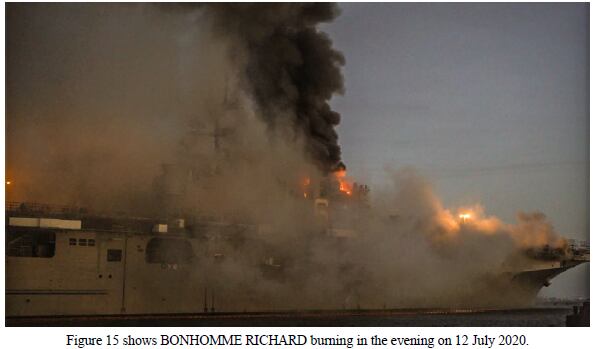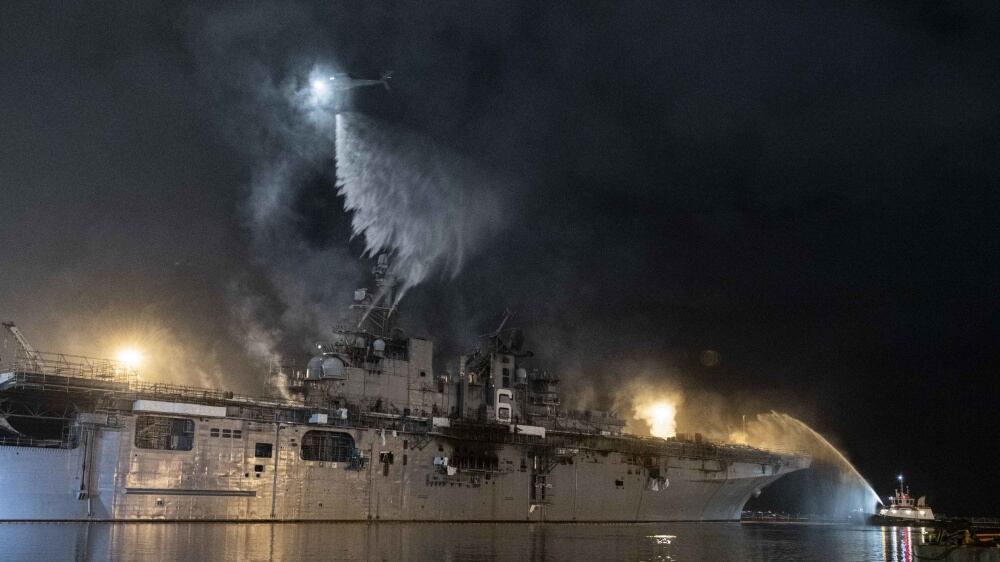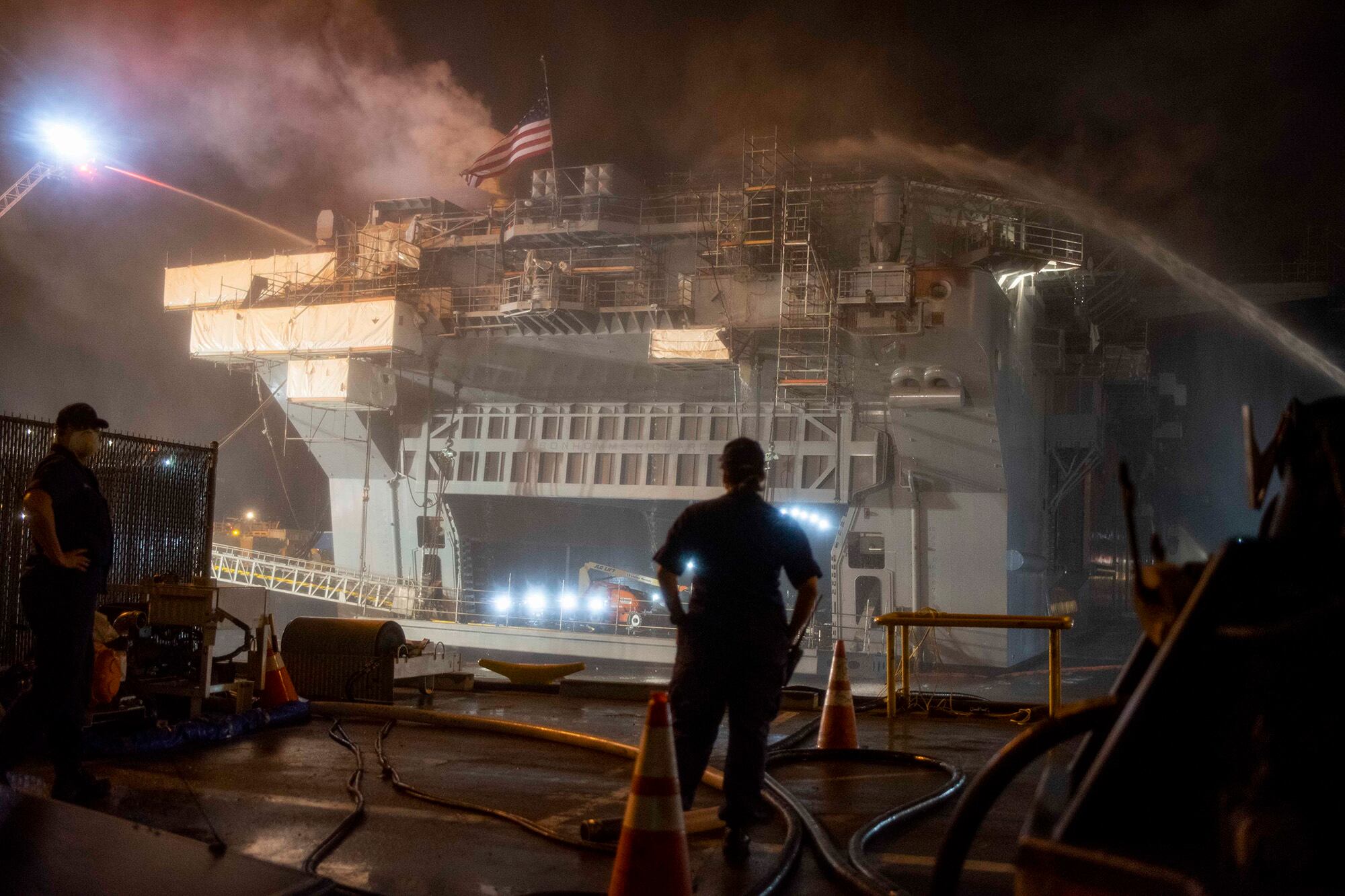When the amphibious assault ship Bonhomme Richard caught fire last summer while undergoing maintenance and then burned for nearly a week, those inside and outside the fleet wondered how such a peacetime loss of a warship could ever happen.
But according to a Big Navy review of ship fires released last week, the threat of such a catastrophe has smoldered inside the sea service’s public and private shipyards for years.
The so-called “Major Fires Review” was released in conjunction with the Navy’s command investigation into the July 12, 2020, fire aboard Bonhomme Richard, which found that the Navy failed at all levels to fight the fire after a junior sailor allegedly started it.
The fires review looked at 15 “shipboard major fire-related events” in the past 12 years and found a series of troubling commonalities.
Aside from the 2012 fire that destroyed the submarine Miami and led to service-wide reforms that were never properly followed, the review looked at fires aboard carriers, amphibs, cruisers, destroyers, minehunters and dock landing ships.
RELATED

The report does not name the ships studied.
Eleven of the 15 fires occurred outside the normal workday when the crew was in duty sections or reduced manning status.
“Reduced manning at the time of the event contributed to command-and-control dysfunction, delayed detection and response, and an increase in severity in nearly all of the fires that occurred outside of normal work hours,” the review states.
The review found that four of the 15 fires were “directly attributable to improper hot work” conducted by public and private shipyard workers, and that six events were attributable to the ship’s crew not properly maintaining or stowing hazardous and combustible material.
Miami’s fire was later found to have been caused by arson, while two other events had suspicious origins and foul play was not ruled out.
Two of the fires had unknown origins.
The review also found that lessons learned from ship fires are not “effectively collected” or disseminated so that the fleet can learn from its mistakes.
The report notes a lack of respect for the fire hazards that abound during shipyard maintenance periods, as well as a proclivity to not keep spaces clean or stow hazardous material properly.
It found ground-level commanders taking on too much risk to get the mission done and not alerting their higher-ups to problems, a finding echoed in the Comprehensive Review that followed two fatal ship collisions in 2017.
The fires review also notes declining standards in watch standing, and failures to address those problems.
It found that crews were better prepared to fight fires while at sea than in the yards, and notes that a lack of training results in sloppy command-and-control when a fire breaks out, an issue that factored into Bonhomme Richard burning for so long.
RELATED

“Historical analysis of the 15 events revealed that ships continue to be less than fully prepared for the maintenance environment, the phase at which the risk of fire is the greatest,” the review states. “This risk increases with the length of the availability, and in particular, during unplanned availability extensions as the crew moves further away from their most recent basic phase certification.”
The review also found problems that extend beyond a ship’s deck plates.
It states that the “overwhelming majority” of piers and berths used for maintenance on Navy bases don’t meet the requirements that were codified in reforms undertook following the Miami fire, which sent the boat to an early retirement.
The report does not name the 15 fire events reviewed, but in recent years, major fires have occurred aboard the guided-missile-destroyer Oscar Austin, the amphibious assault ship Iwo Jima and the aircraft carrier George Washington.
Despite reforms implemented after the Miami fire, the review found that “mishap ships were not fully prepared for the maintenance environment, the very phase at which the risk of fire was the greatest.”
When it comes to the inferno’s origins, the Navy has charged Seaman Recruit Ryan Sawyer Mays with starting the Bonhomme Richard fire.
U.S. 3rd Fleet has yet to release his charge sheet but said that an Article 32 hearing to determine whether his case will go to trial is scheduled for next month.
Among threats to ships undergoing maintenance, the review cites the “significant and largely unmitigated threat with regard to arson and other acts of gross negligence, such as careless smoking,”
“At least three of the fourteen fires either were the result of arson or had suspicious origins,” the review states. “This insider threat represents a critical hazard and requires a formalized and diligent approach.”
Site surveys also dug up issues with the shipyard contractors who are paid eye-watering amounts of taxpayer dollars to work on the ships in the yards.
Navy oversight of contractors varied by location, as did contractor standards.
RELATED

“For some ships in the yards there was a reasonable level of contractor cleanliness, while others had trash, urine bottles, rags, gloves and cigarette butts left onboard each day,” the review states.
Some crewmembers interviewed for the review said they brought contractor concerns to higher levels but that problems would only be fixed for a short time.
“In all private shipyards, the assessors discovered inconsistencies in contractor supervision, and often a clear absence of supervision,” the review notes.
Among prescribed reforms, the review calls for the creation of a Naval Safety Command that can serve as a clearinghouse for non-nuclear safety oversight and enforcement.
Such a command would replace the Naval Safety Center, which the review criticizes for ineffectiveness in assessing trends and overseeing implementation.
The review also calls for ensuring maintenance piers meet proper fire protection requirements, a move that will necessitate “long term planning and funding” but that can be mitigated in the interim.
Geoff is the managing editor of Military Times, but he still loves writing stories. He covered Iraq and Afghanistan extensively and was a reporter at the Chicago Tribune. He welcomes any and all kinds of tips at geoffz@militarytimes.com.




